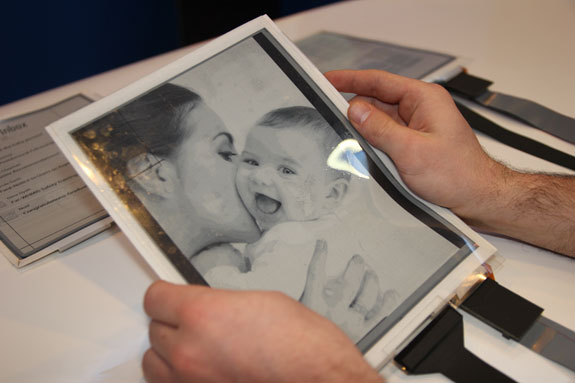

A new paper-thin, flexible tablet developed by GRAND researchers at the Queen’s University Human Media Lab, in partnership with Intel Labs and Plastic Logic, promises to radically change the way users interact with digital media.
Named ‘PaperTab,’ the bendable prototype was officially introduced at the International Consumer Electronics Show (CES) in Las Vegas this week – a tradeshow recognized for showcasing innovative products over its forty-year history. Already the tablet has created a stir among commentators and on social media with largely positive reviews from users over the long anticipated release.
PaperTab looks and feels like a sheet of paper, and offers a robust, shatterproof alternative to conventional glass-based displays. Its touchscreen interface, powered
by the Intel i5 processor, allows users to navigate through a document by bending the corners of the tablet, similar to the turning of pages in a magazine.
Each PaperTab tablet can store and display thousands of documents, but unlike conventional tablets, runs one app at a time (comparable to a single window on a PC desktop). The device also includes several interactive features. By tapping one tablet to another, a user can instantly transfer data, or by placing two tablets side by side, enlarge an image across both screens. PaperTabs are also able to locate themselves relative to each other and to the user, providing a seamless user experience across apps.
.jpg) “Using several PaperTabs makes it much easier to work with multiple documents,” Dr. Roel Vertegaal, Director of the Queen’s Human Media Lab, said in a press release. “Within five to ten years, most computers, from ultra-notebooks, to tablets, will look and feel just like these sheets of printed colour paper.” The PaperTab concept is result of a two-year collaborative effort at Queen’s Human Media Lab (HML) in consultation with Plastic Logic, a UK-based manufacturer of custom flexible displays. The project was funded through NSERC and GRAND NCE.
“Using several PaperTabs makes it much easier to work with multiple documents,” Dr. Roel Vertegaal, Director of the Queen’s Human Media Lab, said in a press release. “Within five to ten years, most computers, from ultra-notebooks, to tablets, will look and feel just like these sheets of printed colour paper.” The PaperTab concept is result of a two-year collaborative effort at Queen’s Human Media Lab (HML) in consultation with Plastic Logic, a UK-based manufacturer of custom flexible displays. The project was funded through NSERC and GRAND NCE.
Vertegaal, a Professor of Human-Computer Interaction (HCI) at Queen's University's School of Computing, works with a team of graduate and undergraduate students, and senior researchers. Graduate students Aneesh Tarun (PhD HML) and Peng Wang (MSc HML) are the current architects of the PaperTab system, however project collaborators include researchers from computing science, design, psychology and engineering backgrounds. The HML is one of Canada’s top media laboratories developing ‘disruptive technologies’ – innovations designed to transform an existing tech market – that would become viable 10 to 20 years from now.
For Vertegaal, the development of the PaperTab prototype and its precursors owes much to the extensive research connections provided through the GRAND network: “The collaborative environment of the GRAND network, which draws together experts from diverse fields, was crucial to the success of this project.”
As well, Intel, one of GRAND’s key industry partners, provided the processor technology for PaperTabs and further funding through a research grant. Ryan Brotman, a researcher at Intel, said in a press release: "The PaperTab project, developed by the Human Media Lab at Queen's University and Plastic Logic, demonstrates innovative interactions powered by Intel Core processors that could potentially delight tablet users in the future."
As for PaperTab’s next steps, Plastic Logic and Intel both state that it will be a few years before the technology is widely deployed. However, many agree the project signals a coming revolution in tablet computing technology.
Related Links
Financial Post
The Globe and Mail
The Guardian
All photos courtesy of Queen's University